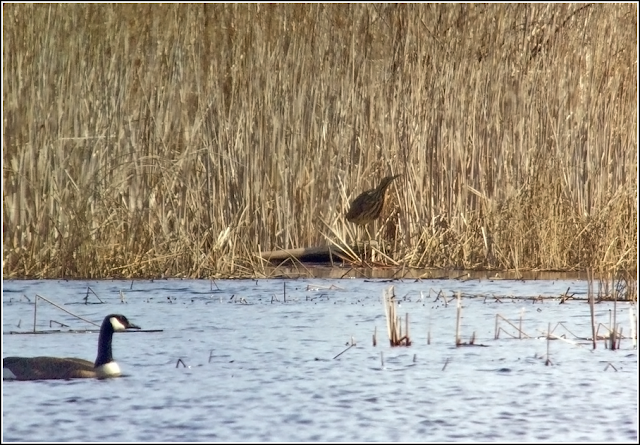258. Forster's Tern
- Port Weller East (April 5) and Port Dalhousie (April 10)
 |
| Forster's Tern - Port Dalhousie, St. Catharines |
Most spring records of Forster's Tern for Niagara are in mid-April as small numbers pass through the region, often before the Common Tern migration begins. The bird at Port Dalhousie was quite accommodating, allowing me to take several photos as it whirled around.
259. Wilson's Snipe
-Stevensville (April 8), Wainfleet Bog (April 23) and Port Weller East (May 2)
 |
| Wilson's Snipe - Port Weller East, St. Catharines |
A long overdue species for me in Niagara! The bird at Port Weller east (photographed above) was a new one for my local patch.
260. American Bittern
-Mud Lake CA (April 8)
 |
| American Bittern - Mud Lake CA, Niagara Region |
Formerly a more common breeding species in Niagara, American Bittern has declined substantially across its range and now is an extremely local breeding species in Niagara Region. In fact, some years this species is not recorded at all in Niagara. According to Birds of Niagara (authored by John Black and Kayo Roy), "there is little evidence to suggest that (American Bitterns) migrate through Niagara in the spring". The book further elaborates to say that the numbers of these birds breeding in Niagara have declined substantially over the years from 1966 to 2006. I discovered this individual at Mud Lake on April 8; fortunately it hung around long enough for Blayne and Jean Farnan to race over and observe it, though others searching later in the day were not as successful as the bittern had retreated to the less visible portions of the marsh.
261. Common Raven
-Wainfleet Bog (April 10)
This species has slowly expanded its range in Ontario to the south and there are now a few known breeding pairs in Niagara Region. I was fortunate to have a bird fly over me calling as I was herping in the Wainfleet Bog in early April. It turns out that Common Ravens are now nesting on the old Robin Hood factory along the Welland Canal at the north end of Port Colborne; no doubt the source for the Wainfleet individual.
262. Louisiana Waterthrush
-Port Weller East (May 1)
This bird was a nice surprise during a fallout on Port Weller East on the first day of the month. I discussed that day's birding in this blog post.
263. Ruddy Turnstone
-Airport Road, Niagara-on-the-Lake (May 26)
 |
| Ruddy Turnstone - Airport Road, Niagara-on-the-Lake |
Back on May 9 I discovered that a flooded cow paddock on Airport Road in Niagara-on-the-Lake was providing great shorebird habitat. This Ruddy Turnstone found by Marcie Jacklin on May 25 was my first for the region. Other highlights among the 15 species of shorebirds found here this spring included ~350 Lesser Yellowlegs on May 9, an adult Stilt Sandpiper on May 16, regular White-rumped Sandpipers including a high of 6 on May 26, Short-billed Dowitchers (griseus subspecies) on May 15 (2 birds) and May 18 (3 birds), and 3 Black-bellied Plovers on May 22 and 23. It is unusual to experience such great shore-birding in the spring in Niagara and the excessive rain throughout May allowed this cow paddock to remain productive throughout the month.
264. Olive-sided Flycatcher
-Moore Rd S, Port Colborne (May 28)
 |
| Olive-sided Flycatcher - Moore Road, Port Colborne |
Blayne and Jean Farnan discovered this bird while birding along Moore Road on May 27 and called me the morning of May 28 to indicate that it was still present, so Laura and I drove down to check it out. Olive-sided Flycatcher is one of my favorite flycatcher species, in part because its can be difficult to turn up in migration despite its inclination to perch high at the top of a dead tree. Eastern Wood-Pewees are sometimes confused with Olive-sided Flycatcher because they also appear "vested", but one great field mark to help separate the two is the surprisingly short tail on an Olive-sided.
265. Brown Pelican
-Niagara River, north end of Fort Erie (May 29)
 |
| Brown Pelican - Niagara River in Fort Erie |
The bird of the year so far in Niagara, this Brown Pelican was first discovered on May 27 by some Buffalo birders (I am not sure who the finder was) and remained on the river until at least June 6, which is the last report I can find on eBird. When I observed the pelican it chose to remain on a buoy on the far side of the river, making even digiscoped photos next to impossible! There are two previously accepted records of Brown Pelican for Niagara Region, and eleven in total for Ontario.
266. Yellow-breasted Chat
-intersection of Willson and Garringer Roads, Wainfleet Bog (May 31)
 |
| Yellow-breasted Chat - Wainfleet Bog |
Another great bird found by the Farnans and Marcie Jacklin! The trio first heard a Yellow-breasted Chat singing from a traditional spot in the Wainfleet Bog and even had brief views of it on May 30. I was on site before dawn the next morning and after a short wait the chat joined in with the dawn chorus. Eventually I located it perched out in the open and I watched it sing for the next hour. Ontario is at the northern edge of the range for Yellow-breasted Chat. Chats were more common in the province several decades ago but it is another species that has undergone recent declines and is now listed as Endangered. Hopefully a female joins this Yellow-breasted Chat as it has been a number of years since this species has been detected breeding in Niagara.








































